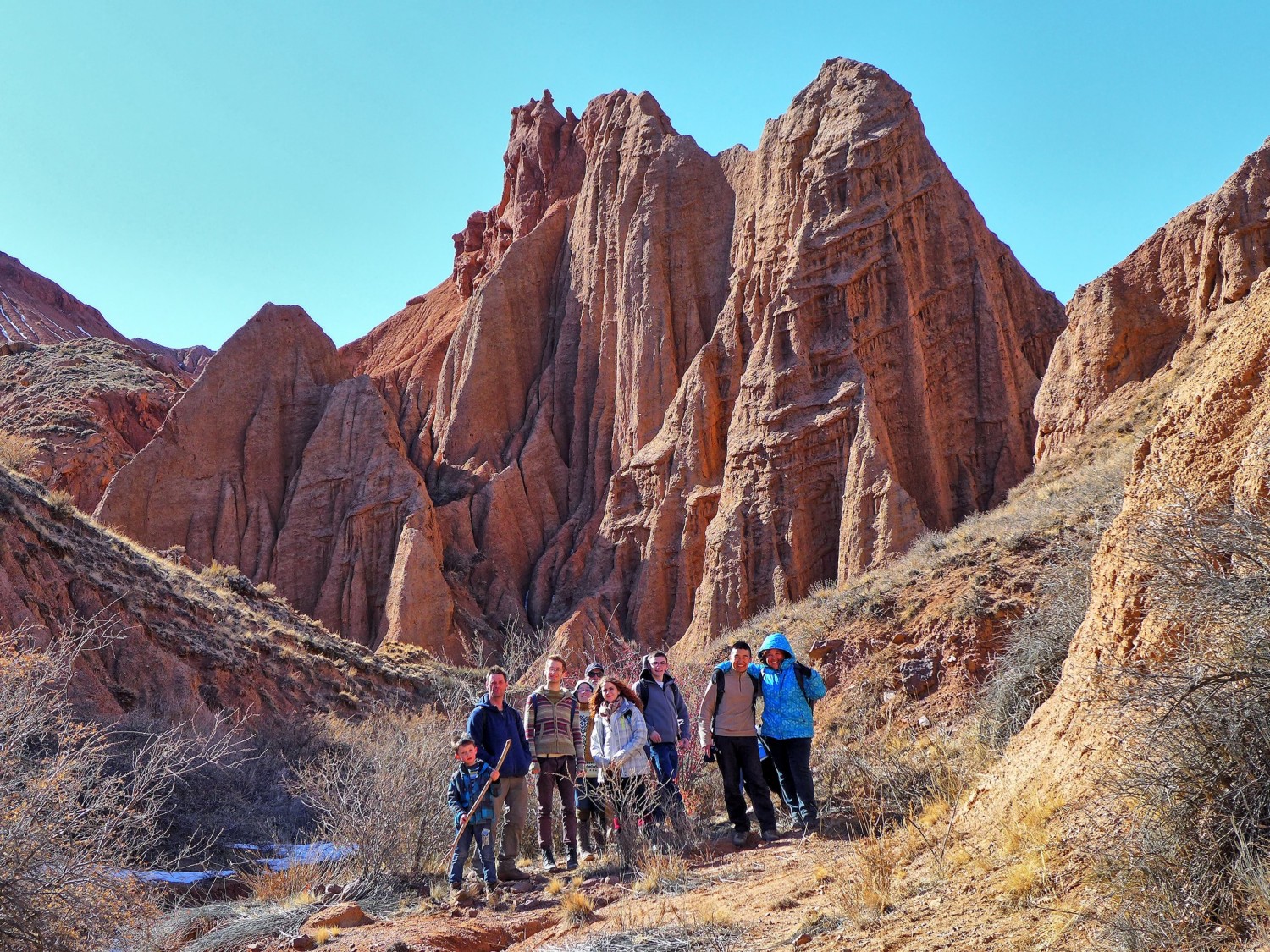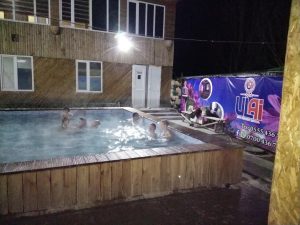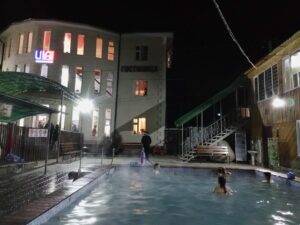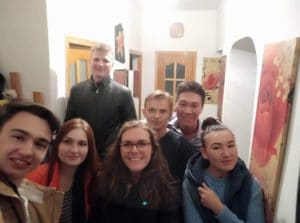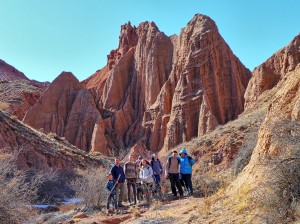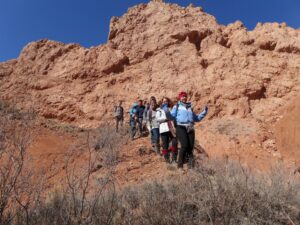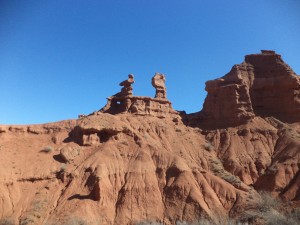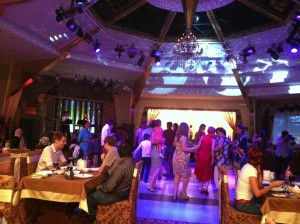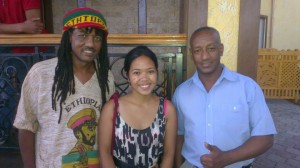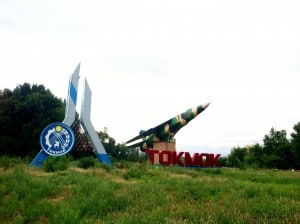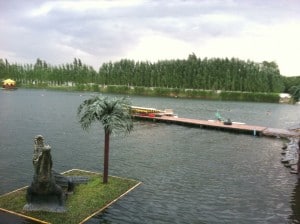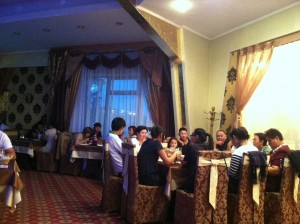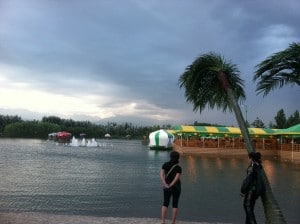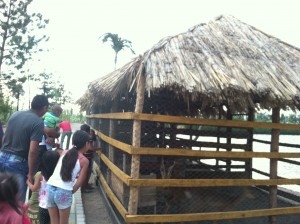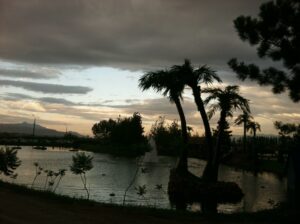Kyrgyzstan is a small country that abounds in natural beauty – many great locations are just a short drive away and can be experienced on a surprisingly small budget. Here are several that students on our study abroad programs in Bishkek recommend!
Issyk-Ata Hot Pools
1 Hour Outside Bishkek; ~$20 budget
Review by Mikaela Peters
On Saturday, November 9th, thanks to a few local friends, I had the opportunity to go to Issyk-Ata. This was right around the time when it was beginning to get fairly cold in Bishkek. Therefore, taking a trip out to a hot springs resort, roughly an hour from Bishkek, was a treat.
In Kyrgyz, Issyk means “warm” and Ata means “father.” These thermal baths are located at the north slope of Ala-Too Mountain, which rises to 1775 meters above sea level at its highest point. Although we hadn’t experienced snow yet in the city, the trip there provided us with views of adjacent snow-capped mountains as we climbed higher in altitude. A group of six of us went, taking a car that of one of my friends owns. Taking a cab there would costs about 500 soms ($7), as it is roughly 45 minutes to an hour outside of the city. Public transportation is also an option, since bus number 316 travels there daily from the East Bus Station in Bishkek. The fare is 50 soms ($0.75). Riding along the way with my friends, many commented on how beautiful Kyrgyzstan is and how they don’t understand why anyone ever wants to leave Kyrgyzstan.
The baths are adjacent to a mini-hotel called Ulai. While there is also a restaurant within this hotel, it seems to be used mostly by people staying in the hotel. People who come to use the thermal bath are usually not there for very long, and don’t seem to stick around for food. The baths are 100 soms ($1.50) per hour, and if you stay in longer than your allotted time, you will be expected to pay more. Dissimilar to other hot spring experiences that I’ve had in other countries, men and women were kept together in one pool and there was no requirement to be nude. You also didn’t have to shower before you got in. There weren’t really too much in the way of facilities. There was one toilet, and it didn’t have a sink anywhere nearby, at least that I could find, and there were two changing rooms. Therefore, there wasn’t an option to shower afterwards if you wanted. Despite the modest facilities, the experience within the hot pool was relaxing and kind of reminded me of being in an outdoor jacuzzi at a ski resort since the air around us was cold. There were even spickets, just like jacuzzi jets, coming out from the ground above the pool, dumping hotter water into the pool. We took turns standing with our backs under these.
After our hour was up, we changed and began the long trek back to town. We had left around 5 PM and sunset this time of year is at 6 PM. Heading back it was close to 8 PM, and, as we had six hungry people in the car, one of our friends invited us to cook a meal together at his home. It turned out that he lived outside of town, in a village called Sokuluk, which was forty minutes west of Bishkek. Thus, it took us about another hour to reach it once we had gotten back into the city, or in other words, it took us approximately two hours to get there, since Issky-Ata is about an hour east of the city. For most in the car, this didn’t seem to be an issue, but for this starving and exhausted person, it felt like an eternity.
After the meal was finally prepared by all in attendance, we ate close to 11 PM and left at midnight to get home by 1 AM. During our dinner conversation, I learned some new words, such as the word for to snore (похрапывать) and listened to the slang of my young friends. The conversation was hard for me to contribute to, in part because of all the slang, so I sat back and mostly just listened.
All in all, the trip to Issky-Ata and the subsequent dinner was a night to remember. For me, it was some long overdue exposure to slang and, therefore, an intellectual challenge. I enjoyed my night out, but by the end of it, was eager to get home, get some rest, and get a shower!
Ala Archa National Park
1 Hour Outside Bishkek; ~$20 budget
Review by Lauren Bisio
As you walk around Bishkek, it’s hard not to notice the snow-capped Tien Shan mountains that dominate the southern skyline. They’re especially well framed by the buildings that line Ala-Too square, and the sight of snow in 100-degree heat can be both invigorating and discouraging. Luckily, when the summer heat and dust begins to overwhelm, Ala Archa National Park is a short drive outside of the city, about 40 kilometers away. This past weekend, I ventured there with some friends to seek respite from the city in the nature you can see tantalizingly close.
While marshrutki don’t go directly to Ala Archa, it is possible to take a taxi. This becomes an especially attractive option when you realize that the trailhead is located 12km from the park entrance. In order to drive those 12km, you’ll have to pay a 200 som vehicle fee in addition to the 80 som/person or 60 som/student fee to enter the park, but it’s well worth it. For those who don’t mind trekking the additional 12km or are planning a longer stay in the park, you can hire a taxi to take you to the park entrance, then call for a return ride at the end of your journey. To make matters even easier, the London School often includes Ala Archa on the itinerary of weekend excursions.
Once inside the park, there’s a guesthouse and some small kiosks and cafes at the trailhead, though most looked unattended when I was there. The trail has a very informative display at the base, including English descriptions and directions, and soon diverges to two itineraries. One trail leads 3.75km to the Ak Sai/Ак Сай waterfall then an additional 2km to the Ratsek/Рацек Hut, while the River Trail trail meanders 1.3km along the Ala Archa river basin, eventually passing an alpinist cemetery. Being well-rested and enthusiastic, my friends and I immediately set out for the waterfall.
Forty minutes later I was sweaty, winded, and famished. While I’d like to blame the altitude (we started at about 7000 feet), the trail was a little steeper than I had bargained for. There’s a small lookout point about 1/3 of the way to waterfall that allows you to sit down, have a snack, and take a break. Luckily, we had packed food and had a delicious mountain lunch of bread, cheese, and samsy. From the lookout we could just make out a waterfall, but the thought of hiking to that distant point seemed incredibly daunting. As we set off again, I promised myself that I could stop at any point and wait for my friends back at the lookout. From this point, however, the trail leveled off a bit and slowly began to offer enticements and rewards for all the hard work: gorgeous views, a river with which to splash cool water on your face, and the increasingly near waterfall. Finally, after about 2.5 hours of ascent, we reached our goal… almost.
We had finally hiked as far as the waterfall, but from our vantage point on the trail it remained another significant hike straight up. One of my friends went for it, and he was quickly at 10,000 feet, above the waterfall and getting closer to snow. I, however, was content to sit by the small stream of water that was flowing down to our location. Surrounded by wildflowers in bathed in the mountain breeze, I took off my hiking boots and soaked my toes in the water. But only for about fifteen seconds, because that water was absolutely freezing! After a nice rest, we packed up and started our descent back to the trailhead and our waiting taxi.
All told we spent about 4 hours hiking around Ala Archa, but by the time I got home tired, thirsty and sunburnt, I felt like I had definitely gotten the full experience. With a range of trails of varying degrees of difficulty, the park has a little something to offer everyone. The best part is the park’s proximity to Bishkek, and knowing that Kyrgyzstan’s famed mountainous terrain is really just around the corner.
Trekking Union of Kyrgyzstan
Multiple destinations; ~$12 Memberships
When you join the Union, you receive a patch and a membership passport-like document that you can fill with the list of all of your future adventures! The cost for joining the union is 420 som ($9). Perks include 50 som or $1 off every trek. There are also discounts at assorted businesses around town for outdoor gear. The Union also rents out gear to members and non-members at their office location. Read more here.
Restaurant Hawaii in Tokmok
1.5 Hours from Bishkek; ~$20 budget
Review by Eirene Busa
One of the most bizarre restaurants I have ever been to in Kyrgyzstan is called “Restaurant Hawaii,” a dining destination outside of Bishkek in a small town called Tokmok. For most people, this restaurant is one of three reasons to visit Tokmok, an otherwise sleepy, dilapidated, still-Soviet-looking town. The other two reasons to visit are to climb the Burana Tower, a Soviet reconstruction of an 11th-century minaret built by the Kharakhanid dynasty; and to do research on Kyrgyzstan’s Chechen diaspora, which at one time included the infamous Tsarnaev brothers who bombed the Boston Marathon this past April.
Restaurant Hawaii was first opened in 2005 by a Uighur businessman. In the last eight years it has skyrocketed to Tokmok (and Bishkek) fame for being a unique complex that offers an indoor and outdoor restaurant; a petting zoo that includes camels, eagles, snakes, and reindeer; a beach and artificial lake that you can swim in; a photogenic water-fountain-lined park to take engagement and wedding photos; and the opportunity to dine on floating huts on the lake, where waiters deliver your orders by boat.
The place oozes both charm and painful artifice, like a cute but obviously fake “town” in Disneyland — only this isn’t California, but one of the poorest countries in Central Asia. One of my dining companions said Restaurant Hawaii was more like Florida-meets-Las-Vegas-meets-Ashgabad, meaning that the idea of bringing Hawaii to Kyrgyzstan is almost as ridiculous as bringing a water oasis to the desert (which both Turkmenistan and Las Vegas did).
Another attraction at Hawaii is its live music. When my friends and I went on a Sunday evening around 7:30pm, there was a live string jazz quartet on the outdoor floating restaurant. There were also two singers/DJs in the main indoor restaurant, which is where we ended up sitting because of the looming, threatening weather. Very quickly, the family-friendly atmosphere turned into a sort of classy club… or clubby wedding. That evening, there was a Kazakh birthday bash that included a bunch of giggling, beautifully dressed, champagne-guzzling yuppies who danced and dined to Russian pop hits and Oriental music. On the dance floor, ladies in long, flowy dresses twirled their delicate fingers and macho men waved their arms and snapped their fingers. Meanwhile, little kids ran around the dance floor, while sober Kyrgyz babushkas in colorful scarves watched from the sidelines. Everyone was enveloped in a clubby purple hue, the flashing lights of a disco ball, and smoke and bubbles pumped from a machine.
The food is solid Kyrgyz/Central Asian fare at very reasonable prices. I ordered a skewer of lamb shashlik and a glass of French red wine, which only cost 200 som ($4.16.) My dining companions also seemed to be quite pleased with their ganfan, a Dungan vegetable and rice dish, and fish. The gem of the meal, however, was the lepyoshka, or round Central Asian bread. It was fresh, soft, and warm.
But you know what the best part of Hawaii was? Meeting a slice of the Ethiopian diaspora in Kyrgyzstan. A very small slice. Two ethnic Ethiopians work at Hawaii as meet-and-greeters and entertainers, and they have an amazing story to tell.
Hailu and Nassir are two Ethiopians who have lived in Kyrgyzstan for 23 years and have worked at Hawaii since it opened. They first came to Kyrgyzstan in 1989 as Ethiopian air force cadets, where they studied at a military training facility that specialized in flying combat aircraft. (At the time, the Soviet Union trained Ethiopian pilots for the Ethiopian Air Force under Mengistu Haile Mariam’s Marxist regime.) After the collapse of the Soviet Union and the overthrow of the Mengistu regime in 1991, they remained in Kyrgyzstan out of fears of reprisals back home for supporting the brutal deposed leader. Though I am not sure where the rest of the former Ethiopian pilots have gone, Hailu and Nassir have told me that eight remain in Kyrgyzstan today, out of the original 80: five in Tokmok and three in Bishkek. Of the five in Tokmok, Hailu and Nassir work at Hawaii, two others work as taxi drivers, and one is a pastor at a Baptist Church.
Hailu and Nassir seem to have completely adopted Kyrgyzstan as their new home, for better or worse. They no longer speak Amharic with each other, but Russian. Hailu married a Kyrgyz woman, and together they have a son, who only speaks Russian and Kyrgyz. Hailu did mention visiting Addis Ababa once in 2004, and both Hailu and Nassir admitted missing Ethiopian food, such as the Ethiopian spongy bread known as injera, doro wat (chicken stew), tej (honey wine), and of course Ethiopia’s famous black, sweet coffee. (Ethiopia is known as the birthplace of coffee.) I’ve spent some months in Addis Ababa myself and fell in love with its rich, spicy food, so it was fun reminiscing over our favorite dishes.
But looking back, it was an odd conversation. If you think about it, I conversed with Ethiopians about Ethiopian food, in “Hawaii,” in Kyrgyzstan. Really, this country is one of the most diverse countries I have ever been to, full of endless surprises and fascinating personal histories. I think our experience at Hawaii was particularly strange for us that day because en route Tokmok, we passed by a small village called Rotfront, a historically German village where Stalin deported a lot of Germans during WWII, and met two of the last five Germans remaining there. They were blond-haired, blue-eyed, and spoke German, Russian, and English. The village had originally been founded by German settlers under the Tsarist government and Stalin had then changed its name to honor a paramilitary organization under the leadership of the Communist Party of Germany during the Weimar Republic. By the time we got to Hawaii, we were so deep down the rabbit hole we didn’t know what to do with ourselves.
So we danced. By the end of the evening at Hawaii, the three of us foreigners — a Filipina-American, a French New Yorker, and a Scotsman — let loose on the purple-hued, smoke-filled, bubbly dance floor, shimmying to a Brazilian pop song alongside Kazakh men in shiny black shoes and ladies in five-inch-heels, and our new Ethiopian friend, Nasir in his dreadlocks and Rastafarian garb. We must have been quite a sight. But then again, we were in Hawaii, Kyrgyzstan.
You Might Also Like
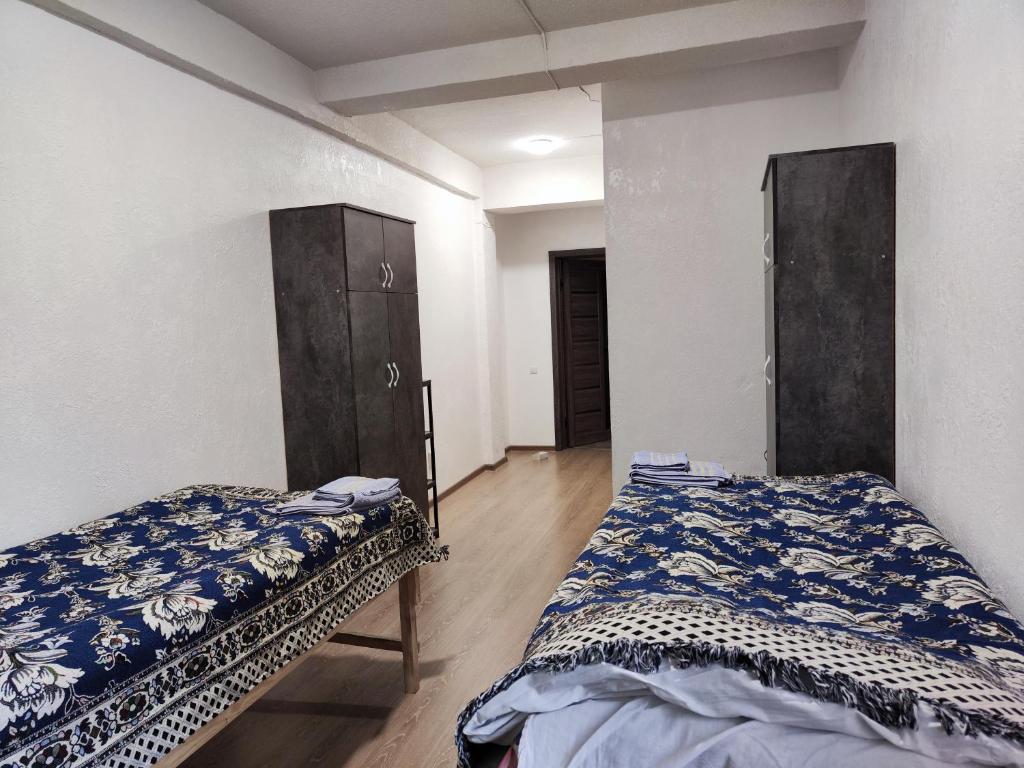
Bishkek Housing
In Bishkek, you have two living options: a home stay or a dormitory. Each comes with its own pros and cons. The following student reviews are meant to help you make your housing decision and prepare for your time abroad on SRAS programs in Bishkek. Bishkek Dormitories SRAS students stay at the Nomad Inn, a […]
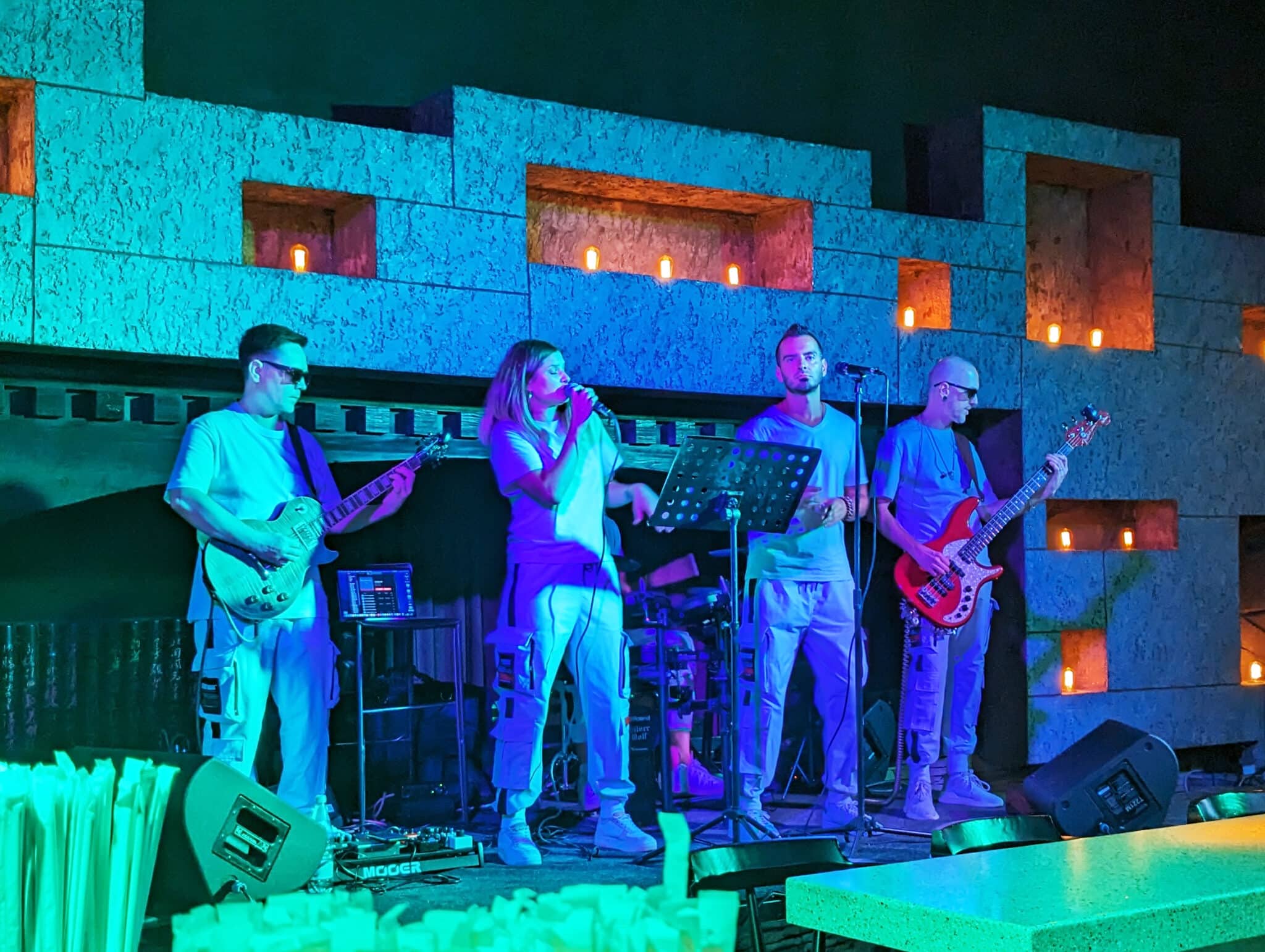
4 Places with Great Live Music and Food in Almaty, Kazakhstan
Almaty has many live music venues and all-night clubs, meaning that with a bit of asking around or internet surfing, one can find the perfect place to have a bite and a drink, catch a local band, and dance the night away. Some are holes-in-the-wall known mostly to locals while others are bigger venue places […]
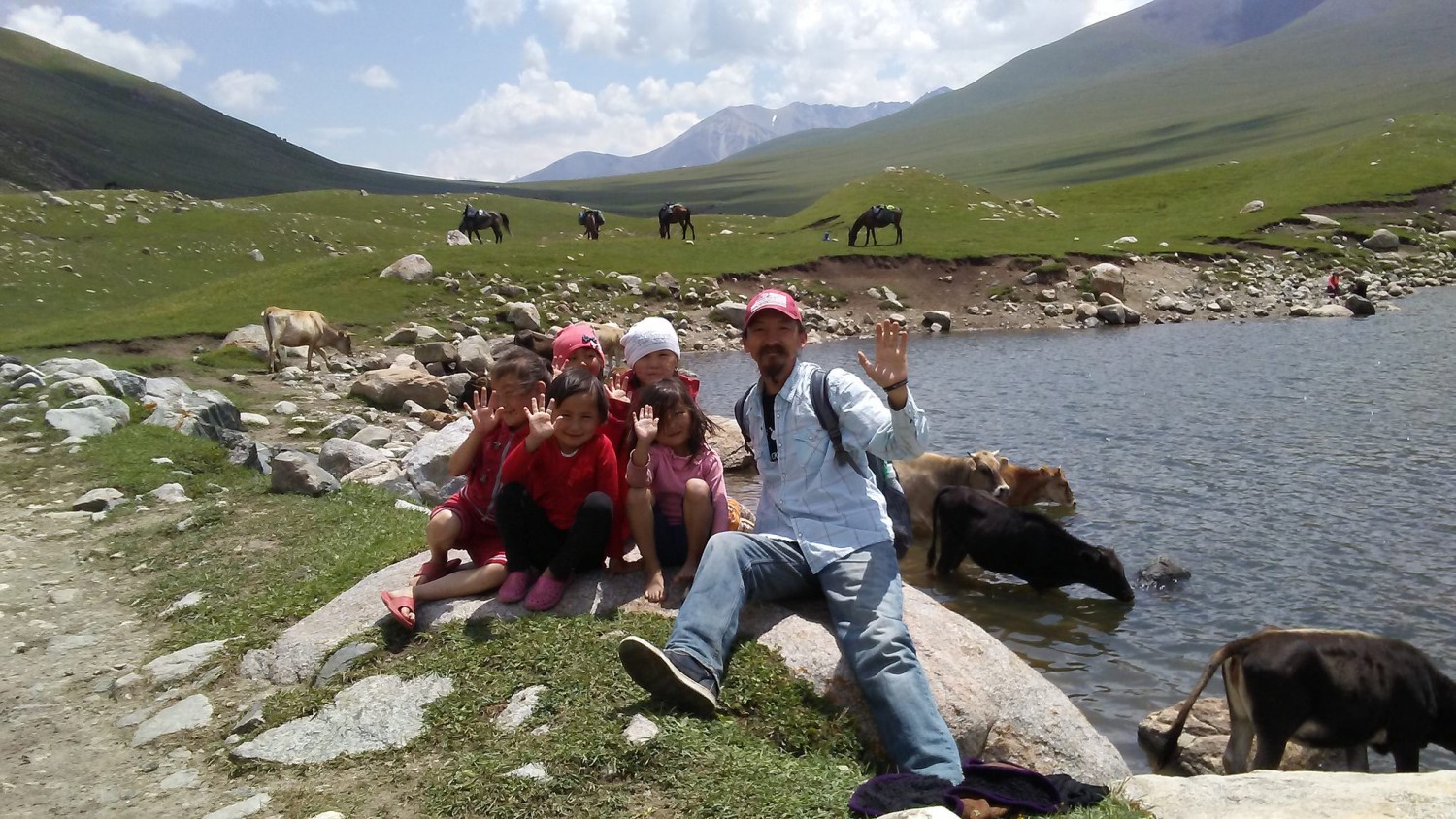
SRAS Guide to Living in Bishkek
What’s it really like to live in Bishkek for a semester? Staying long-term in a city is much different from just vacationing there. You’ll need to navigate more of the practical, everyday services of the city and budget to include more miscellaneous and long-term expenses. Thus, this guide covers everything from haircuts to pharmacies and […]
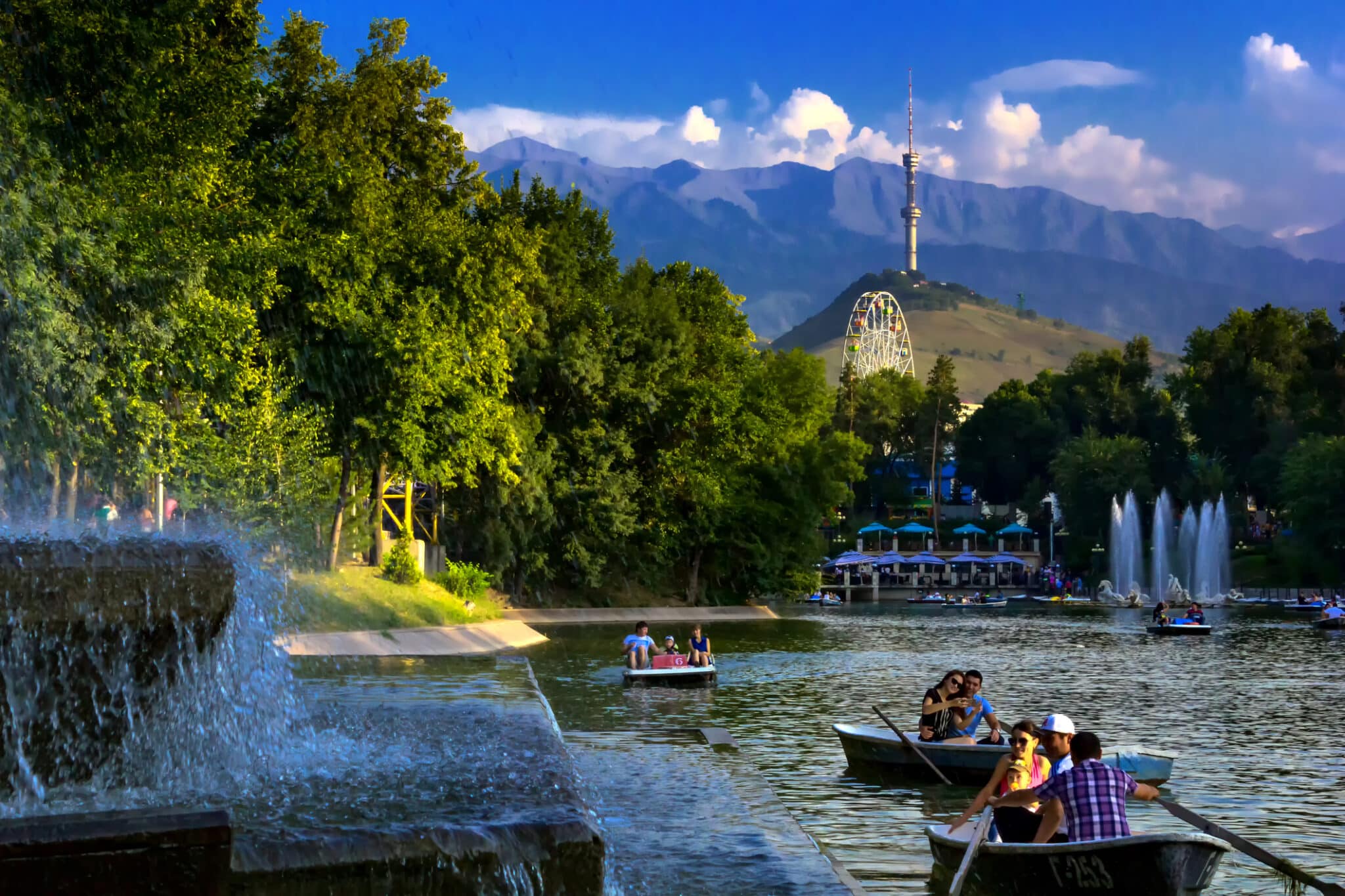
Travel to Almaty from Bishkek
At the end of my summer program in Bishkek, a friend of mine and I wanted a weekend getaway from Bishkek and decided to visit Kazakhstan’s largest city and former capital, Almaty, which is just over the border. A few other students had already gone and encouraged us to check it out. Almaty lies at […]
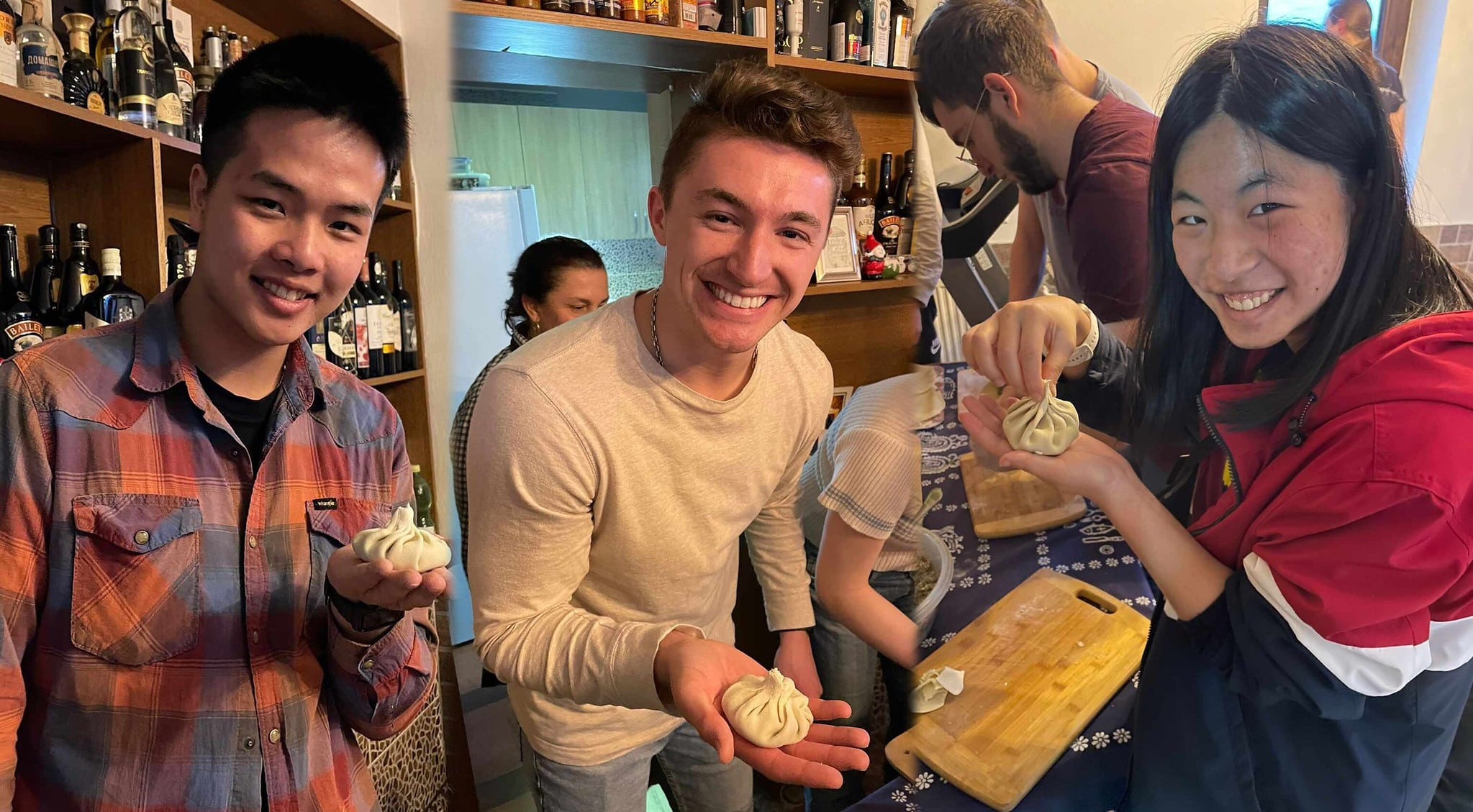
Preparing for and Coping with Culture Shock
Some of our students report not feeling culture shock at all. Some are surprised by how much culture shock they experience. Often, those most affected are those who did not expect it. So how can you prepare to live in a new culture and get the most out of the experience? How do you prepare […]

